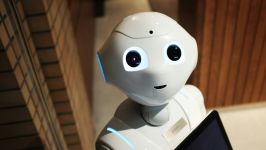
Artificial intelligence continues to transform how we address real-world challenges. In 2024, the pet tech industry saw a breakthrough with the launch of AI-based behavioral analysis tools, which can interpret animals' emotions and behaviors with unprecedented accuracy. Startups like Companion and Petpuls gained attention for their innovative AI systems, including smart collars and emotional analysis apps, which provide pet owners with actionable insights into their pets' needs. These developments underscore the increasing demand for AI solutions beyond traditional fields, introducing new possibilities to niche areas such as wildlife conservation and pet care.
One of the standout projects in this space is led by Oleksandr Khodorkovskyi, a tech leader and entrepreneur known for applying artificial intelligence to tackle unconventional problems. With a background in developing groundbreaking platforms such as ShodennikUA, which revolutionized digital education in Ukraine and beyond, Khodorkovskyi has demonstrated the power of combining AI and computer vision. ShodennikUA integrated AI-based tools for test monitoring and progress analysis, offering personalized recommendations to teachers and parents. The rapid advancement of artificial intelligence, especially the emergence of large language models, opened a new frontier for Khodorkovskyi's work—the ability to interpret animal emotions and behaviors.
Now, Oleksandr's focus is on an AI platform for dog owners that goes beyond basic activity tracking to interpret pets' emotions and behaviors. As he explains, the project builds on his previous experience using computer vision to understand and improve human interaction with systems, making the leap from classrooms to homes.
How the Idea Works
Khodorkovskyi's platform is an intelligent mobile application with a "long memory," designed to learn deeply about both the pet and its owner. It analyzes photos and videos of the dog, synthesizing meaningful insights about its condition and behavior. In addition, the system seamlessly integrates with smart cameras and pet collars.
Using real-time computer vision and data analysis, the platform monitors the dog's health, habits, and emotional state. Based on these observations, it provides personalized recommendations for care, training, and nutrition.
For instance, if the AI detects signs of stress, it suggests specific actions, such as adjusting the pet's walking routine or modifying its nutrition.
"Our technology can interpret subtle signals through body language or facial expressions," explains Khodorkovskyi. "This helps owners better understand their pets' needs or discomforts."
A key feature of the platform is its ability to continuously monitor dogs' activity. For example, if it notices repetitive behavior or prolonged inactivity, it flags potential boredom or stress. The platform is also integrated with the owner's calendar and map, suggesting optimal times for walks or interactive play sessions to improve the pet's well-being.
Addressing Gaps in the Market
The growing market of pet tech solutions often focuses on basic features like activity monitoring or feeding reminders. However, Oleksandr's platform takes a fundamentally different approach, leveraging AI-driven behavior analysis to provide insights that were previously unavailable.
According to Khodorkovskyi, the platform's potential extends beyond private homes:
"We see huge opportunities for these technologies in animal shelters. AI could improve living conditions and help match pets with suitable owners more effectively. This would not only enhance the lives of animals but also strengthen human-animal bonds."
Educational Impact and User Feedback
Another focus of the platform is educating pet owners. Beyond recommendations, the app teaches users to recognize their dogs' behavioral signals, which is especially valuable for first-time owners.
Oleksandr said, "When owners understand their pets better, it leads to more harmonious and fulfilling relationships."
Feedback from early adopters confirms the platform's impact. Many reported significant improvements in their pets' behavior and reduced stress in day-to-day life. Additionally, the AI's ability to detect early signs of health issues helps prevent more serious problems, offering peace of mind to pet owners.
Building on a Legacy of Innovation
Khodorkovskyi's current work reflects a natural progression from his earlier projects. At ShodennikUA, his team successfully implemented AI to improve educational outcomes, integrating computer vision for test proctoring and academic monitoring. These tools not only ensured integrity in remote learning but also provided detailed insights into student performance, helping educators tailor their approaches.
Beyond education, Khodorkovskyi has extensive experience in gaming technology. As the founder of Argentics, a game development company, he pioneered AI to create dynamic NPC dialogues that adapt to game narratives. This work in behavioral simulation and interaction design proved invaluable when developing systems to interpret real-world animal behavior—in both cases, the challenge is understanding and responding to non-verbal communication patterns.
"Our work with ShodennikUA was about giving educators tools to make better decisions. Now, with the AI pet care platform, we're doing the same for pet owners—empowering them with the knowledge they wouldn't have access to otherwise," Oleksandr explains.
A New Chapter in Human-Animal Relationships
While humanity debates the global possibilities of artificial intelligence, projects like Khodorkovskyi's show how AI can transform even the most unexpected aspects of our lives, from helping pet owners understand their dogs better to improving conditions in animal shelters. Applying advanced AI solutions opens doors to more meaningful relationships between humans and animals.
"This is the real magic of AI—not to replace humans but to give them superpowers. For instance, the ability to understand those who cannot speak," says Khodorkovskyi. "With the right technologies, we can make life better not only for people but for the animals we share it with."
The question is no longer whether AI can interpret animal behavior—platforms like this prove it can. The more interesting question is what happens when these tools become widespread. If technology can detect a shelter dog's stress levels or compatibility with potential owners, does that change adoption outcomes at scale? If pet owners receive real-time alerts about behavioral changes that precede health issues, do veterinary practices adapt their diagnostic approaches? The gap between what animals experience and what humans perceive has always existed. Computer vision and behavioral analysis don't eliminate that gap, but they narrow it enough to make a difference. As AI moves into spaces beyond obvious commercial applications, the real test isn't technical capability—it's whether these systems create measurable improvements in how we care for beings that can't advocate for themselves.









